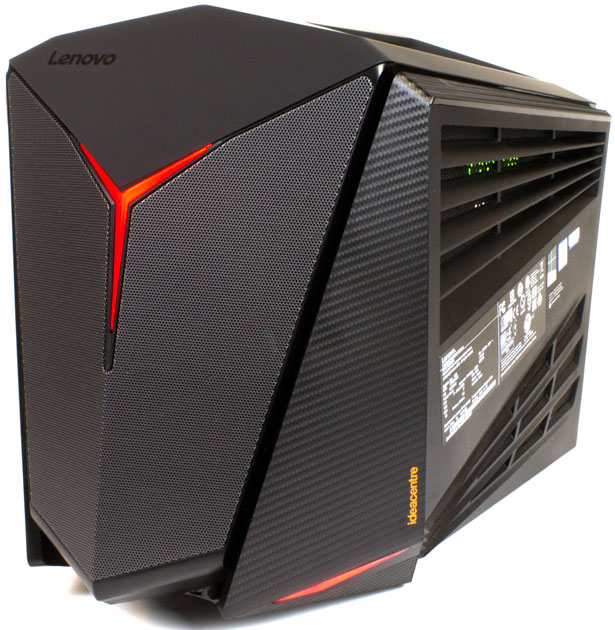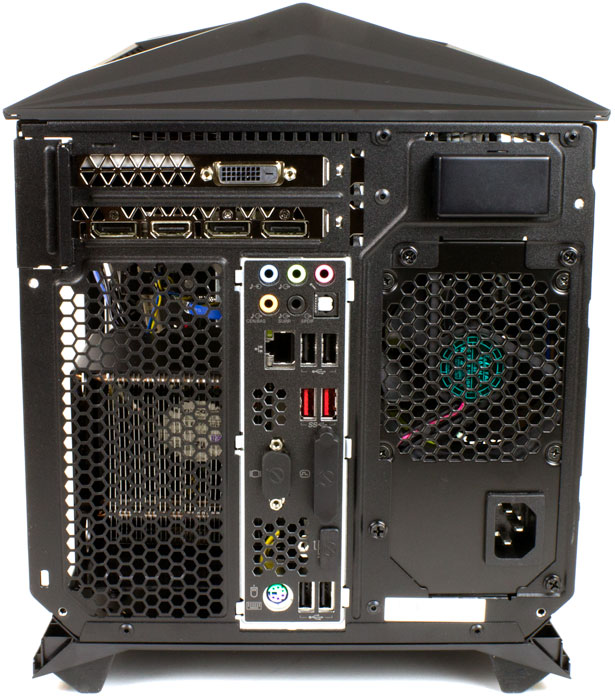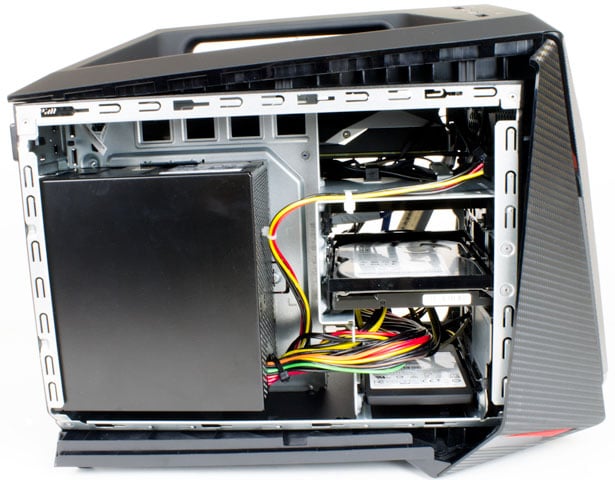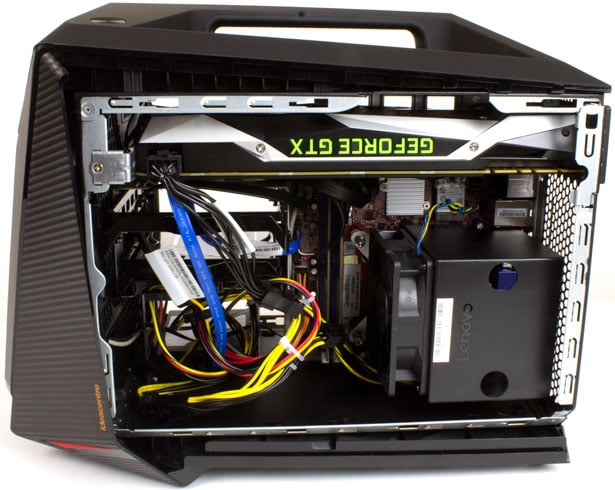Lenovo IdeaCentre Y710 Cube Review: Big Gaming Performance In A Small Package
Lenovo IdeaCentre Y710 Cube: Design And Build Quality
Compact PCs tend to be either tall and thin (like the Digital Storm Bolt 3) or short and squat. Lenovo’s IdeaCentre Y710 Cube falls into the latter category, standing 9.93 x 12.38 x 15.48 (W x H x D) inches. The underside of the handle has rounded edges, making for a solid, comfortable grip, but the width of the system affected the way we carried it. We expected to be able to carry the Y710 Cube as smoothly as we would a briefcase, but the PC bumped our legs unless we held it out a bit from our bodies. The result is that carrying the Y710 Cube isn’t quite as comfortable as carrying, say, a laptop bag, but it’s much easier than lugging around a full-size PC. For the trip from a car to our spot at a LAN event, we’d take the Y710 Cube over a hulking desktop any day.
The Y710 Cube weighs in at 16.3 pounds – or more, depending on the configuration. That’s much more than the typical gaming laptop (the Dell Inspiron 17 7000 Gaming we recently checked out weighs just 5.76 pounds) but doesn’t come close to the weight of a full-size gaming desktop. The Maingear Vybe, for example, weighs 45 pounds, when configured with dual GTX 1070s and a liquid cooling system.
Small though it may be, the Y710 Cube has all the toughness (both real and aesthetic) you could want from a desktop PC. The front of the system glows with a red, Y-like LED and two LED accents near the front feet. The top of system sports a number of red vents that only come into view at certain angles, giving the Y710 Cube a mostly-black appearance until you’re right on top of it. It’s a polished, cool chassis that will turn heads.
As for its physical toughness, the PC is sturdy enough to take the bumps and bangs of travel in stride. That handle doesn’t flex a bit when we lift the system. And the Y710 Cube’s squat design works for it when the PC is in a car; it doesn’t tip or roll during ordinary driving.
The front panel connections aren’t unusual: two USB 3.0 ports, audio and mic jacks, and the power button. Lenovo put them at the top of the system, near the handle, which means your headset jack will break up the sleek look of the Y710 Cube when it’s plugged in (more than, say, if the ports were on the side of the system). That’s not likely to be a problem for most users, though.
Most of the ports are at the back of the Y710 Cube, including two USB 3.0 ports, four USB 2.0 ports, audio jacks, the Gigabit LAN port, and a PS/2 port for legacy or gaming peripherals. (Some mechanical keyboards use the PS/2 port for true n-key rollover.) The GeForce GTX 1070 sports a DVI port, three Display Ports and an HDMI port.
The Y710 Cube ships with an unassuming keyboard and mouse, both of which are wired, but neither of which are targeted directly at gamers. Lenovo offers Y-series gaming keyboards, mice and headsets for gamers who want to stick with the brand, but desire a bit more flash.
Expandability is an important characteristic of any desktop, but even more so in a gaming PC, which will probably see a graphics card update (or two) in its lifetime. We don’t expect an SFF like the Y710 Cube to have much in the way of extra room, but we can insist on easy access to components that are bound to be upgraded in the future.
Both of the Y710 Cube’s side panels are removable and are held in place with traditional thumbscrews. The right-hand panel typically reveals the motherboard in most desktops, but in this case, it provides access to just the 450W, 80-Plus Bronze certified power supply. You can also see the back ends of the drive cages from this side. Weirdly, Lenovo put the product information stickers on the exterior of the left side panel. You can remove them, of course, but some of that information (including the serial number) is worth hanging onto. The back of the system (where these stickers usually appear) doesn’t have enough space to accommodate this info. Still mucking up the side of the system seems counterproductive, especially with a flashy gaming chassis such as this one.
Open the Y710 Cube’s left side, and you’re in business. A good chunk of the space on this side is eaten up by the tower-style CPU cooler, with copper heat pipes and aluminum fins. A shroud surrounds the heatsink, directing air out the back of the PC.
The GeForce GTX 1070 sits at the top of the systems, within easy reach of anyone preparing an upgrade. We’re a little disappointed Lenovo didn’t build a small window into the case panel to showcase the “GeForce GTX” banner on the card, though. You can also access the drives from here. The system sports a 2.5-inch bay (filled by the 128GB SSD in our test PC) and two 3.5-inch bays. In our test system, one of those bays houses the 1TB hard drive, while the other has an empty drive sled.
Our only beef with the interior is the cable management. Lenovo bundled some of the cords, but those bundles hang free in the system, blocking the drive cages and the two memory slots. In fact, the memory is tough to reach, thanks to both the nearby cords and the CPU heatsink fan. A memory upgrade wouldn’t be impossible, but it looks like a bear. Call us spoiled if you will, but after years of checking out the artwork-like cable management in systems built by boutique PC makers, we couldn’t get excited about the cabling here.
The rock-solid side panels go on as easily as they come off, and lock firmly into place. As we mentioned before, every inch of the Y710 Cube feels solid and looks polished – cabling aside. Of course, good looks won’t get a PC very far if it doesn’t have game, so let’s take a quick look at the software and then dig into the benchmarks.
The Y710 Cube weighs in at 16.3 pounds – or more, depending on the configuration. That’s much more than the typical gaming laptop (the Dell Inspiron 17 7000 Gaming we recently checked out weighs just 5.76 pounds) but doesn’t come close to the weight of a full-size gaming desktop. The Maingear Vybe, for example, weighs 45 pounds, when configured with dual GTX 1070s and a liquid cooling system.
Small though it may be, the Y710 Cube has all the toughness (both real and aesthetic) you could want from a desktop PC. The front of the system glows with a red, Y-like LED and two LED accents near the front feet. The top of system sports a number of red vents that only come into view at certain angles, giving the Y710 Cube a mostly-black appearance until you’re right on top of it. It’s a polished, cool chassis that will turn heads.
As for its physical toughness, the PC is sturdy enough to take the bumps and bangs of travel in stride. That handle doesn’t flex a bit when we lift the system. And the Y710 Cube’s squat design works for it when the PC is in a car; it doesn’t tip or roll during ordinary driving.
The front panel connections aren’t unusual: two USB 3.0 ports, audio and mic jacks, and the power button. Lenovo put them at the top of the system, near the handle, which means your headset jack will break up the sleek look of the Y710 Cube when it’s plugged in (more than, say, if the ports were on the side of the system). That’s not likely to be a problem for most users, though.
Most of the ports are at the back of the Y710 Cube, including two USB 3.0 ports, four USB 2.0 ports, audio jacks, the Gigabit LAN port, and a PS/2 port for legacy or gaming peripherals. (Some mechanical keyboards use the PS/2 port for true n-key rollover.) The GeForce GTX 1070 sports a DVI port, three Display Ports and an HDMI port.
The Y710 Cube ships with an unassuming keyboard and mouse, both of which are wired, but neither of which are targeted directly at gamers. Lenovo offers Y-series gaming keyboards, mice and headsets for gamers who want to stick with the brand, but desire a bit more flash.
Expandability is an important characteristic of any desktop, but even more so in a gaming PC, which will probably see a graphics card update (or two) in its lifetime. We don’t expect an SFF like the Y710 Cube to have much in the way of extra room, but we can insist on easy access to components that are bound to be upgraded in the future.
Both of the Y710 Cube’s side panels are removable and are held in place with traditional thumbscrews. The right-hand panel typically reveals the motherboard in most desktops, but in this case, it provides access to just the 450W, 80-Plus Bronze certified power supply. You can also see the back ends of the drive cages from this side. Weirdly, Lenovo put the product information stickers on the exterior of the left side panel. You can remove them, of course, but some of that information (including the serial number) is worth hanging onto. The back of the system (where these stickers usually appear) doesn’t have enough space to accommodate this info. Still mucking up the side of the system seems counterproductive, especially with a flashy gaming chassis such as this one.
Open the Y710 Cube’s left side, and you’re in business. A good chunk of the space on this side is eaten up by the tower-style CPU cooler, with copper heat pipes and aluminum fins. A shroud surrounds the heatsink, directing air out the back of the PC.
The GeForce GTX 1070 sits at the top of the systems, within easy reach of anyone preparing an upgrade. We’re a little disappointed Lenovo didn’t build a small window into the case panel to showcase the “GeForce GTX” banner on the card, though. You can also access the drives from here. The system sports a 2.5-inch bay (filled by the 128GB SSD in our test PC) and two 3.5-inch bays. In our test system, one of those bays houses the 1TB hard drive, while the other has an empty drive sled.
Our only beef with the interior is the cable management. Lenovo bundled some of the cords, but those bundles hang free in the system, blocking the drive cages and the two memory slots. In fact, the memory is tough to reach, thanks to both the nearby cords and the CPU heatsink fan. A memory upgrade wouldn’t be impossible, but it looks like a bear. Call us spoiled if you will, but after years of checking out the artwork-like cable management in systems built by boutique PC makers, we couldn’t get excited about the cabling here.
The rock-solid side panels go on as easily as they come off, and lock firmly into place. As we mentioned before, every inch of the Y710 Cube feels solid and looks polished – cabling aside. Of course, good looks won’t get a PC very far if it doesn’t have game, so let’s take a quick look at the software and then dig into the benchmarks.














